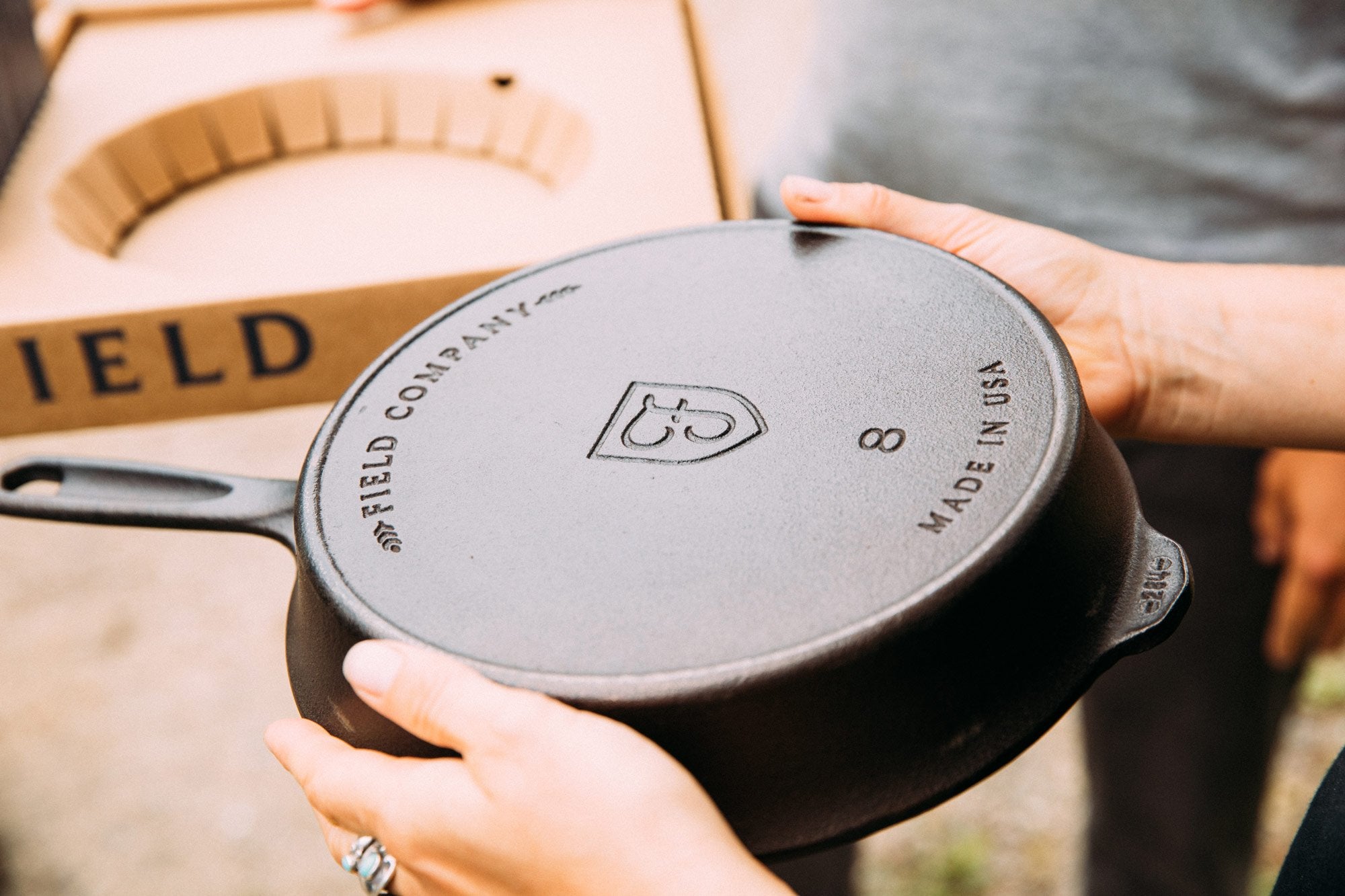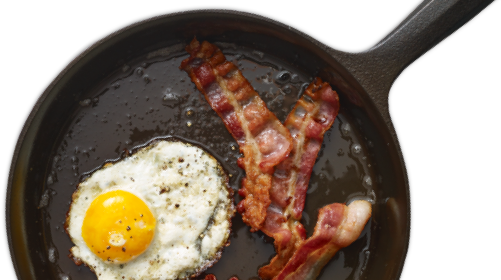A great cast iron skillet is understated in its form and over delivers on its function. But the Field Skillet’s simple silhouette and classic cast iron patina belie the depth of research and testing that informed its design. Here, we highlight a selection of the tough design choices that produced the skillet on your stovetop.

Handles with care
We’ve covered the handle design in detail before, because it’s such an important part of the experience of cooking. The handle is where you interact most directly with the skillet, and a well-designed handle contributes to a positive cooking experience.
Field Skillets are lightweight, in absolute terms: our cookware is more akin to vintage cookware than the heavy, rough skillets most commonly used today. But beyond pounds and ounces, the Field Skillet feels lighter because of its handle.

First, the handle itself is lighter because we’ve removed excess material from areas that don’t need it: flip the pan upside down and you’ll see a slimmed-down underside where we’ve eliminated iron that would add weight. But even more important to the sense of lightness and maneuverability is its balance. Our handle’s dimensions are calibrated to make sure your hand and arm never feel strained, even when lifting a fully loaded pan.
Our handle’s details take things a step further. The subtle ridge down the center of the handle helps you situate your grip when picking the pan up. (And it looks very cool when the light hits it just so.) And our shield-shaped hanging hole both echoes a Field family emblem and makes sure it’s easy to hang your skillet on the kitchen wall (on those rare occasions when it isn’t on the stovetop).
Smooth—but not too smooth
Vintage, hand-machined skillets are prized for their non-stick cooking performance, a function of surface texture and, often, years of steady use. So, when cookware manufacturers—Field Company included—emulate vintage cast iron skillets, a smooth cooking surface is a must. But it’s too easy to slip into a smooth=good / rough=bad binary: the science behind seasoning is a little less black and white.
Seasoning craves texture. When certain cooking oils are heated, they polymerize, bonding to the cooking surface to create the dark, smooth and non-stick layer we call seasoning. If the cooking surface is too smooth, that fresh layer of seasoning won’t adhere—short-circuiting the virtuous cycle that creates reliable non-stick cooking.

Field Skillets use a machining process modeled on the best of vintage cookware and precisely dialed in to leave just a touch of texture on the cooking surface. The minute ridges you see if you really squint at a brand-new skillet create sites for our factory seasoning to take hold, and quickly fill in as you start cooking at home. This is the foundation that makes your skillet non-stick, and it gets better every time you cook.
A century ago, this machining was all done by hand. Today, we’re able to lean on a partially automated process where skilled operators can precisely deliver an optimized surface texture, weight, and balance: three of the most important factors in determining future cooking performance.
Vintage-style heat ring
The heat ring is one of our favorite Field Skillet features: it’s both a reference to cookware conventions in a bygone era, and a clever way to meet the performance challenges of contemporary kitchens.

During the 19th Century, cast iron cookware was designed to fit the cooking apparatus common to American kitchens: the wood-burning stove. Skillets were sized to fit burner “holes,” and the heat ring at the base of the skillet ensured an exact fit on the stovetop. Field Skillets derive their numbered sizing (No.8, No.10, etc.) from standard wood-stove burner sizes, and our heat ring carries the reference through to the casting itself.
Today, smooth-top electric and induction stoves create a different sort of performance challenge: on a level stovetop, an unbalanced skillet won’t sit flat. Our heat ring is designed to make sure the Field Skillet remains balanced as it heats up on glass or ceramic cooktops. And at just 0.04” of clearance, our heat ring won’t interfere with cooking performance or lose any power from induction heat elements.
Pour Spouts
When we released the Kickstarter campaign for the very first Field Skillet, it wasn’t the cooking surface, weight or shape of our prototype pans that caused the most controversy: it was the “missing” pour spouts. Of course, our spoutless skillets weren’t an oversight; rather, they were a product an a-ha! moment backed by extensive research and testing.
From the 1870s to the 2010s, most cast iron skillets came with at least one pour spout about 90 degrees rotation either side of the pan’s handle. The use case for a pour spout is straightforward: use the spout to pour excess liquid from the pan, be it bacon grease, frying oil, or braising juices. Without a pour spout, the same task makes a mess. A few quick tests exposed a basic flaw in this convention: pour spouts still drip!

And that’s not all they do: they increase manufacturing complexity, and by extension cost. Once that lightbulb went off, we realized there was no need to include a feature that would be more expensive to produce and more expensive to the customer for little tangible benefit. Instead, we leaned into what Field Skillets do best.
Early in the research phase, we developed precise metallurgical standards required for lightweight, thin-walled cast iron cookware. (The short version: thin walls require a strong microstructure, which in turn requires precisely calibrated flow rates and pouring temperatures at the casting stage.) Without pour spouts, we’re able to maintain uniform wall thickness around the edges of the Field Skillet, keeping overall weight down without sacrificing strength.

As the sidewall rises to its edge, the shape flares outward slightly, similar to the edges of a spoutless pitcher. When cooking liquid reaches the edge, it pours smoothly in a single stream with minimal dripping—just like a pour spout, without the extra cost and complexity.
Born-on dates
Vintage cookware often includes distinct maker’s marks: cryptic clues to an individual skillet’s backstory cast right into the iron. Field Skillets include a unique marking of their own, if you know where to find it.

On the underside of the helper handle, you’ll find a three or four-digit alphanumeric series signifying the pan’s casting date. For most Field Skillets out in the wild, that will be a four-digit series in YMDD format, reading something like 1J21, translated September 21, 2021.
Flip over your skillet, decode your date, put it on the calendar, and make plans to cook something special.




